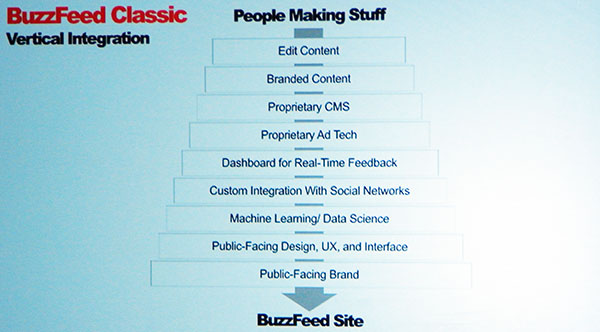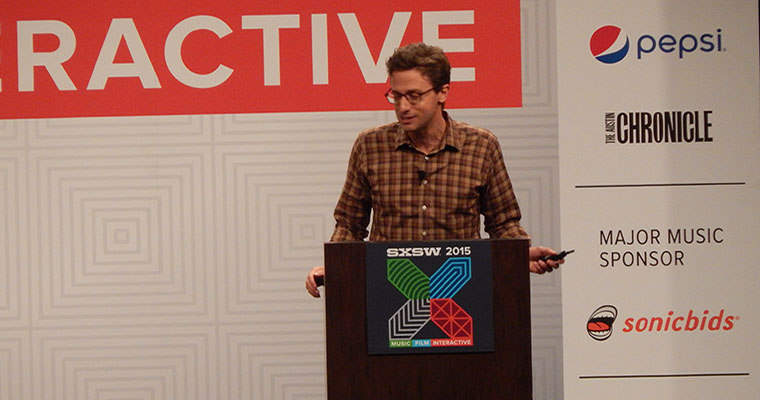I went to another BuzzFeed session today (my last one was takeaways from BuzzFeed publisher Dao Nguyen) because I consider BuzzFeed one of the top publishing outlets online today. Jonah Peretti’s featured session, simply titled Lessons From BuzzFeed, brought a lot of useful insight into why BuzzFeed has become so successful.
Peretti started out his session with two key points, which carried throughout the conversation:
“Media and communication have really started to converge.”
and
“When you share funny stuff with your friends or those in your network, you are sharing an experience and feel closer to that person.”
In a nutshell, these are the two concepts that drive BuzzFeed’s success. With over 900 employees, Peretti states that BuzzFeed “never focused on pageviews or clicks. Sharing with another person means so much more.”
On a holistic view, social media allows people to get more connected into each other’s lives, and sharing drives more conversations about people’s personal lives. To respond to this, the BuzzFeed Life division was created is to make people’s lives better.
Other popular sections of the site that Peretti covered was their video and news divisions:
BuzzFeed Motion Pictures and News
[pullquote]”We didn’t set out to build a site for millennials. We built a platform for how people consume media today.” -Jonah Peretti, CEO/Founder of BuzzFeed[/pullquote]
Peretti focused part of his session on two growing sectors of BuzzFeed: Motion Pictures, which is their video division, and News. The Motion Pictures division began in 2011 and after buying Ze Frank’s company, they have their own production space with three buildings. This video division has now grown to 1B+ monthly views and 7.5B+ views to date.
When speaking about news, Peretti stated they’ve been successful with breaking news because “having a [site that is] commonly read by the public gives us an advantage.” Over 50% of millennials read BuzzFeed, which gives them the responsibility to give breaking and in-depth news to their audience.
Growing BuzzFeed’s Impact: Becoming More Distributed
SXSWi 2015 is the first place BuzzFeed is officially talking about their new distribution model:
 BuzzFeed’s new integration strategy
BuzzFeed’s new integration strategyBefore beginning to utilize this new network integration strategy, most of BuzzFeed’s efforts (and the traditional model for most sites) is to drive as much traffic as possible their website. However, Peretti states, “the shift to mobile has already happened, and now companies are trying to figure out how to adapt.”
For BuzzFeed, this meant launching BuzzFeed BFF, which is a group focused entirely on not driving traffic to BuzzFeed. Instead, they use channels like Instagram, Tumblr, and others to get engagement and consider themselves “Special Ops” for trying to understand media in our society and how to capitalize on it. [pullquote]”Even if content is distributed, you can still learn from it.”[/pullquote]
This shift to publishing content is places other than the BuzzFeed site resulted from their discovery that impressions in users’ social media streams is far greater than actual clicks to the content. For example, this is the ratio of clicks to impressions for their top three social referrers:
- Facebook: 349M clicks, 11.3B impressions
- Twitter: 12.5M clicks, 847M impressions
- Pinterest: 60M clicks, 6.4B impressions
Peretti then encouraged the audience to consider publishing content to the stream itself, not just links to the content. He stressed that impressions do matter because they provide interactions and data.
Vertical Integration
[pullquote]”We aren’t a product, we are service that can get better and better over time.”[/pullquote]
One thing that gives BuzzFeed the power to take data and learn from it is that they have vertical integration, which means everything, from their CMS to their graphics, is done in-house. This means they can easily change and experiment without waiting for a third-party.
 BuzzFeed’s Former “Traditional” Vertical Integration Model
BuzzFeed’s Former “Traditional” Vertical Integration Model
What Does This Look Like in Practice?
Peretti then gave three examples (for each of the sections in the photo above) for how their new content and publishing model is going to work:
- Traditional Publishing Model – The Dress: It generated 40 posts total across BuzzFeed, which combined had over 52M+ views (verticals included the original post, pop culture, news, science, and celebrities). 8.6M+ views originated from one single FB post, 975K+ views originated from one tweet.
- New App – Cute or Not: Their new app is a “Tinder for pets,” according to Peretti. They launched by putting promotion on all of BuzzFeed’s properties (social media, apps, website, editorial content, newsletter, and end cards on video). Cute or Not is also partnering with Friskies as a sponsor soon and their next step is to internationalize it.
- Distributed Content – Video with President Obama, “Things everyone does but doesn’t talk about:” Published solely on Facebook’s native video stream. BuzzFeed also created gifs and Vines to go with it and the Tumblr community also created gifs. The video was actually created in 9 minutes because they had the experience to know what connected with the audience ahead of time.
Peretti closed the session with a few key takeaways, included below, and also stated, “for us, it increasingly doesn’t matter where our content lives.” He told the audience to get better at your job every day and continue to capitalize on their available data to make decisions on content publishing and distribution.
Key Takeaways:
- Having an international presence is really important for media companies (BuzzFeed has 90+ million non-US monthly unique pageviews).
- Sharing is meaningful.
- Impact is even more meaningful.
- How to have bigger impact:
- Scale internationally
- Build a great business
- Become more distributed
- BuzzFeed’s network integration model lets us learn from everything they do, no matter where the content lives.
Photos taken by author.





